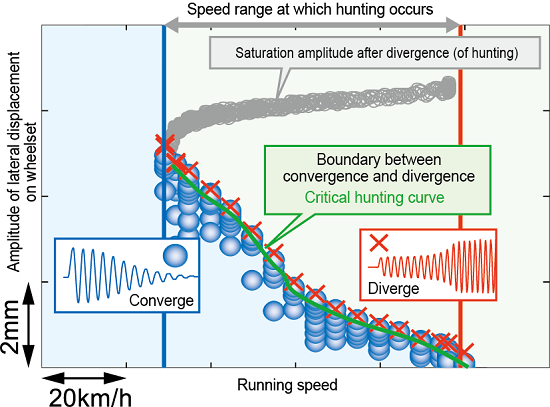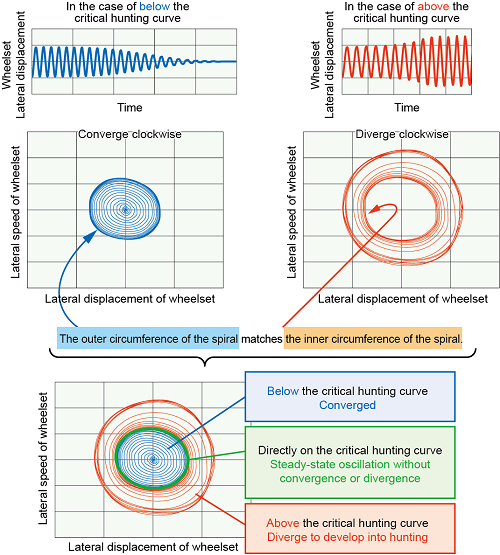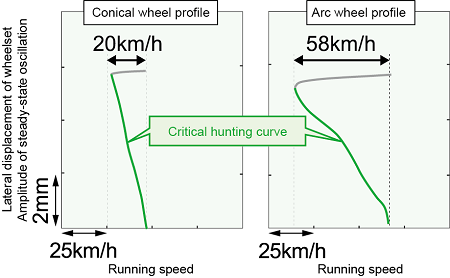23. Analytical evaluation method for the speed at which hunting occurs
The phenomenon where a bogie suddenly starts lateral movements at a certain speed, which develop into large amplitude oscillation, is called "hunting." Since hunting has a significant impact on the running safety of vehicles traveling at high speed, the speed at which hunting occurs is confirmed to be sufficiently higher than the operating speed using a rolling stock test plant during the development of new vehicles. However, it is known that the speed at which hunting occurs varies depending on how the initial amplitude of lateral displacement is given on the wheelset in the test. This relationship between the initial amplitude and the speed at which hunting occurs is called the critical hunting curve (Fig. 1). The relationship between these two has not been theoretically clarified before. In this study, we have constructed an analytical method for calculating the critical hunting curve based on the specification of the vehicle and the wheel tread profile.
Fig. 1 shows that an oscillation diverges to the hunting above the critical hunting curve, and one converges below it. It also shows theoretically there could exist a steady state oscillation on the critical hunting curve that neither converges nor diverges. This indicates that the steady state oscillation is unstable, which means that the oscillation will diverge or converge by even slight disturbance (Fig. 2). Therefore, we have constructed a method to calculate the amplitude of steady-state oscillation corresponding to a point on the critical hunting curve by applying a nonlinear calculation method to the vehicle dynamics model. In this method, we can efficiently obtain a solution by using the characteristics of a critical hunting curve that decreases monotonically as a whole when the running speed increases. With this method, it is possible to analytically evaluate the speed at which hunting occurs according to the initial amplitude of the wheelset.
In addition, we have clarified that the speed range in which hunting occurs expands when the nonlinearity increases, as in the case of arc wheel profile where the tread gradient changes depending on the contact position with the rail, compared to the conical wheel profile having constant tread gradient (Fig. 3).
Other Contents
- 22. Numerical simulation of ventilation in a vehicle by opening windows while running
- 23. Analytical evaluation method for the speed at which hunting occurs
- 24. Evaluation of the influence of wheel machining marks on the friction coefficient by visualizing the contact area
- 25. Wheel slide protection simulator to supplement on-track testing
- 26. Non-contact method to detect rail openings using aerial ultrasonic waves
- 27. Clarification of wear mechanism of current collecting materials caused by frictional heat
- 28. Method to evaluate physical properties of frictional materials by numerical simulation
- 29. Detection of changes in drivers' physical and mental state using physiological indicators
- 22. Numerical simulation of ventilation in a vehicle by opening windows while running
- 23. Analytical evaluation method for the speed at which hunting occurs
- 24. Evaluation of the influence of wheel machining marks on the friction coefficient by visualizing the contact area
- 25. Wheel slide protection simulator to supplement on-track testing
- 26. Non-contact method to detect rail openings using aerial ultrasonic waves
- 27. Clarification of wear mechanism of current collecting materials caused by frictional heat
- 28. Method to evaluate physical properties of frictional materials by numerical simulation
- 29. Detection of changes in drivers' physical and mental state using physiological indicators



